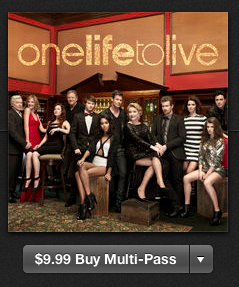All My Commodities: Valuing the Online Soap Opera
 When ABC canceled One Life to Live and All My Children in 2011, it was based on the determination that they were no longer valuable to the network’s daytime lineup. When Prospect Park licensed the properties to revive them online, surviving a lengthy struggle with unions to bring the two series back to life, it was because they believed there was still value in those properties under a different set of metrics operating within digital distribution.
When ABC canceled One Life to Live and All My Children in 2011, it was based on the determination that they were no longer valuable to the network’s daytime lineup. When Prospect Park licensed the properties to revive them online, surviving a lengthy struggle with unions to bring the two series back to life, it was because they believed there was still value in those properties under a different set of metrics operating within digital distribution.
However, in prominent popular discourse surrounding the series’ return, journalists have privileged the value of the programs to producers rather than their value to audiences. While talk of profit margins is all well and good, the two soaps’ move online involves asking audiences to accept new definitions of a soap opera’s value—once “free” over broadcast—within the television marketplace. Although the product itself—its characters, its narratives, its evolution—will determine its ultimate value to fans, Prospect Park’s release strategy intersects in complicated ways with discourses of televisual value within an evolving space of digital distribution, which is being adapted in order to fit the specificity of an atypical televisual form.
When broadcast networks started selling their shows through the iTunes Store, it was a pivotal moment for the digitization of media content and the growing impact of convergence on industry business models. However, it also rearticulated our conception of televisual value by placing a distinct price on an episode of television as a discrete twenty- or forty-minute entity.
This articulation was part of the larger digital distribution revolution: while iTunes and its competitors Amazon Instant Video and YouTube continue to sell individual episodes, streaming services like Hulu, Netflix, and Amazon Prime have reframed televisual value through access to expanded libraries of content, largely leaving the iTunes model as an industrial afterthought (albeit one which is still useful for cord-cutters).
Prospect Park’s distribution strategy for All My Children and One Life To Live is an unorthodox merger of these two business models. Their primary partnership with Hulu—under their “Hulu Exclusives” acquisition strategy—is itself a combination of two different streaming logics: the online Hulu service features recent episodes of the series for free, ad-supported web browser streaming, while the multi-platform Hulu Plus service—$7.99 a month—will have the entire library of each series along with HD ad-supported streaming to tablets, game consoles, Roku players, etc. In order to articulate these options, particularly to viewers—imagined as older viewers in popular discourse—unfamiliar with online streaming, Hulu drafted One Life to Live stars for a video explanation:
In the process, Prospect Park and Hulu have dissected the experience of watching soap operas on television into two discrete values. The first is being able to “revive their daily drama habit”—to use Hulu’s marketing rhetoric—for free, with the caveat that their viewing must remain daily (as only the most recent episodes will be available). However, the second is the ability to “relax on your sofa and watch on your TV,” which Hulu has commodified by limiting device-based streaming to its subscription service. The distinction allows viewers to determine which parts of their soap viewing experience were most valuable to them, and specifically asks if watching on a television—or on a tablet—is worth $7.99 a month.
 And yet Prospect Park’s arrangement with iTunes is even more interesting, given that no currently running soap operas are distributed through the service (whereas Days of our Lives and General Hospital also stream on Hulu). They are offering what they call a “Multi-Pass,” which is comparable to a “Season Pass” for primetime series with one caveat: instead of an entire season, it instead gives viewers twenty episodes—or four weeks—of a series for $9.99; viewers can also choose to purchase individual episodes for $0.99.
And yet Prospect Park’s arrangement with iTunes is even more interesting, given that no currently running soap operas are distributed through the service (whereas Days of our Lives and General Hospital also stream on Hulu). They are offering what they call a “Multi-Pass,” which is comparable to a “Season Pass” for primetime series with one caveat: instead of an entire season, it instead gives viewers twenty episodes—or four weeks—of a series for $9.99; viewers can also choose to purchase individual episodes for $0.99.
Whereas the Hulu arrangement asks viewers to place a value on their soap viewing habits, the iTunes arrangement explicitly asks viewers how much they are willing to pay for an episode of a soap opera. Prospect Park’s choice of $0.99 is half of what iTunes charges for primetime television episodes in standard definition (Hulu Plus remains the exclusive home of high-definition episodes), a decision that reflects the large volume of content viewers are expected to pay for—hence the Multi-Pass discount of $0.50 an episode—but also reinforces existing hierarchies of value between daytime and primetime programming.
However, the two soaps also fit somewhat awkwardly into the logics of streaming, given that one of the key values of streaming services—an extended library of previous episodes—is thus far unavailable to the two programs. Although one could expect that many fans of the two shows would invest in the ability to access decades of soap opera content through a streaming service like Hulu, the ability to revisit previous episodes has less perceptible value when there are thus far no previous episodes to revisit (as ABC’s stake in the new ventures—as license holders—is not strong enough for them to actively support Prospect Park with such library content beyond 8-10 minute recaps for potential new viewers).
Although it’s unclear what kind of data Prospect Park will be releasing—it will, as always, depend on whether releasing the data has value to them—any determinations about the “value” of the two relaunching soap operas have to be withheld until we understand how audiences respond to these initial articulations. While online distribution is often framed as offering audiences new ways to experience television, the habit-based nature of soap viewing has led Prospect Park and Hulu to devise and promote specific distribution strategies which emulate more traditional viewing patterns, at a price.
As a result, the stakes of this project are neither as simple as Prospect Park’s financial investment in All My Children and One Life To Live nor as broad as the very future of digital distribution. Rather, the specificity of this experiment will determine what value soap audiences have within future conceptions of digital distribution, their acceptance or rejection of industrial definitions of value shaping how and where they will be programmed to in the future.



Thanks for this, Myles. I have been overwhelmed by the popular press discourse on this this week. There is definitely an effort to refigure these shows as something “other” than soap opera in hopes of reaching that audience of young people who, the rhetoric goes, already watch their TV online. Yet PP recognizes that they can’t give up the continuing viewers, so they are trying to find ways to explain accessing the show to them. In so doing, it really replicates the sense of “old” soap viewers as aging, outdated, traditionally feminized. The publicity is much more focused on what is new here than on continuing a TV legacy.
Thanks for your comment, Elana. I was encouraged by Abigail de Kosnik being cited in Stelter’s NYT piece, as her tie back to the early days of television does a lot to reassert the value of Soaps. It just seems like no one is following through on analyzing that history, choosing instead to sort of absently suggest “Soaps are a part of TV history” while mostly looking forward. I understand the impulse, but Prospect Park’s actual strategies are not quite as forward-looking as some of the press suggests: yes, this is a big experiment in online distribution, but it’s also a very specific one. As happy as I am that they’re taking it seriously despite being about soaps, that they’re not taking it as distinct to soap opera viewing is eliding important parts of the discourse.
Myles, thanks for really interesting points about serials and digital distribution! I wonder if audiences will continue to accept the low budget production values (multicam, live-on-tape, etc.) in return for the daily episode? In linear TV, the daily episodes were possible only because of cheap production values. But now that we can also watch high-production-value serials in nonlinear environments (e.g. Breaking Bad on Netflix), do you think nonlinearity could shape audiences’ aesthetic expectations? and so affect audience size for these soaps?
Cynthia, I’m not sure there is such a drastic difference in production values anymore. Digital video has really blurred the line between the looks of video and film. Surely long time soap viewers will not be bothered by the production values, which look to me as “good” as broadcast soaps. And if the shows do attract new viewers who are more used to online viewing these are surely people who see many of the very low budget/production value pieces made for the web and have also been acclimated to the sometimes inconsistent quality of streaming video in general. AMC and OLTL look way more professional than your average YouTube vid.
Yeah, I would agree with this. Mind you, I did think that the outdoor “action” scenes in the OLTL pilot were a little bit rough, but not outside of what I’ve come to expect from soaps more generally. In addition, if you have people who are used to watching web video and who choose to watch for free on Hulu, the lack of HD streaming would also be an equalizer of sorts.
And while Elana’s right that they’re hoping to draw in new viewers with edgier storylines—a lot of the press is about the swearing—I don’t know if they see it as a competitor—or companion—for high-production serials so much as for other primetime soaps that sit somewhere in between. The shows’ launch coincided with the Monday morning release of episodes of shows like Once Upon a Time and Revenge, and I would think those are the kind of viewers they would be actively courting to take up a daily habit to go along with their weekly ones.
Great piece!
I’ve been watching both shows and following the limited information being released. So far they are doing well on Hulu and iTunes (in the top 5 for Monday).
PP and the actors/actresses from both shows have been connecting for months with fans on Facebook and Twitter, which was a smart move to connect with younger demographic that they want.
I can’t wait to see what happens next week. Right now AMC and OLTL fans are in the honeymoon phase with their shows (and PP). I’ve seen very little backlash, negative criticism, etc. from fans. I wonder how long it will take before we see tweets from fans threatening to stop watching AMC or OLTL because they don’t like a certain storyline or want a certain actor/actress on the show.